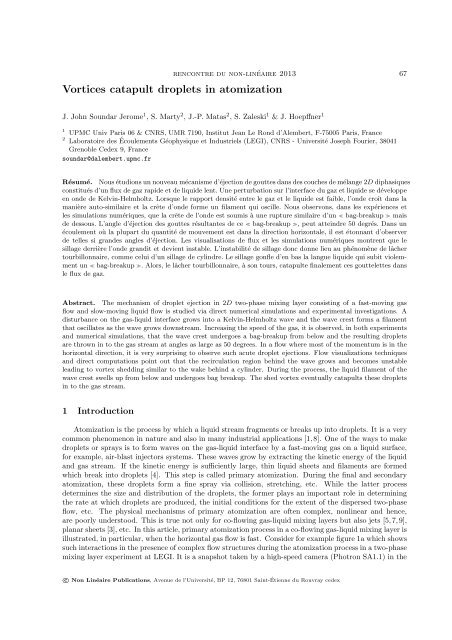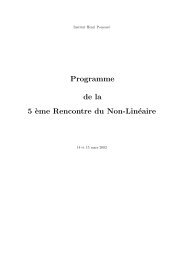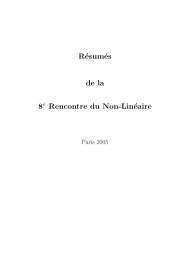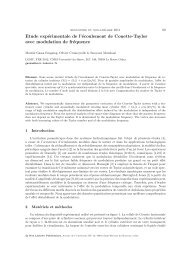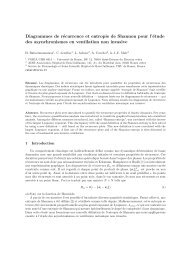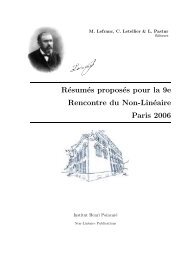Rencontre du Non-Linéaire
l'intégralité des comptes-rendus - science non linéaire
l'intégralité des comptes-rendus - science non linéaire
- No tags were found...
Create successful ePaper yourself
Turn your PDF publications into a flip-book with our unique Google optimized e-Paper software.
encontre <strong>du</strong> non-linéaire 2013 67<br />
Vortices catapult droplets in atomization<br />
J. John Soundar Jerome 1 , S. Marty 2 , J.-P. Matas 2 , S. Zaleski 1 & J. Hoepffner 1<br />
1 UPMC Univ Paris 06 & CNRS, UMR 7190, Institut Jean Le Rond d’Alembert, F-75005 Paris, France<br />
2 Laboratoire des Écoulements Géophysique et In<strong>du</strong>striels (LEGI), CNRS - Université Joseph Fourier, 38041<br />
Grenoble Cedex 9, France<br />
soundar@dalembert.upmc.fr<br />
Résumé. Nousétudionsunnouveaumécanismed’éjectiondegouttesdansdescouchesdemélange2D diphasiques<br />
constitués d’un flux de gaz rapide et de liquide lent. Une perturbation sur l’interface <strong>du</strong> gaz et liquide se développe<br />
en onde de Kelvin-Helmholtz. Lorsque le rapport densité entre le gaz et le liquide est faible, l’onde croît dans la<br />
manière auto-similaire et la crête d’onde forme un filament qui oscille. Nous observons, dans les expériences et<br />
les simulations numériques, que la crête de l’onde est soumis à une rupture similaire d’un ≪ bag-breakup ≫ mais<br />
de dessous. L’angle d’éjection des gouttes résultantes de ce ≪ bag-breakup ≫, peut atteindre 50 degrés. Dans un<br />
écoulement où la plupart <strong>du</strong> quantité de mouvement est dans la direction horizontale, il est étonnant d’observer<br />
de telles si grandes angles d’éjection. Les visualisations de flux et les simulations numériques montrent que le<br />
sillage derrière l’onde grandit et devient instable. L’instabilité de sillage donc donne lieu au phénomène de lâcher<br />
tourbillonnaire, comme celui d’un sillage de cylindre. Le sillage gonfle d’en bas la langue liquide qui subit violemment<br />
un ≪bag-breakup ≫. Alors, le lâcher tourbillonnaire, à son tours, catapulte finalement ces gouttelettes dans<br />
le flux de gaz.<br />
Abstract. The mechanism of droplet ejection in 2D two-phase mixing layer consisting of a fast-moving gas<br />
flow and slow-moving liquid flow is studied via direct numerical simulations and experimental investigations. A<br />
disturbance on the gas-liquid interface grows into a Kelvin-Helmholtz wave and the wave crest forms a filament<br />
that oscillates as the wave grows downstream. Increasing the speed of the gas, it is observed, in both experiments<br />
and numerical simulations, that the wave crest undergoes a bag-breakup from below and the resulting droplets<br />
are thrown in to the gas stream at angles as large as 50 degrees. In a flow where most of the momentum is in the<br />
horizontal direction, it is very surprising to observe such acute droplet ejections. Flow visualizations techniques<br />
and direct computations point out that the recirculation region behind the wave grows and becomes unstable<br />
leading to vortex shedding similar to the wake behind a cylinder. During the process, the liquid filament of the<br />
wave crest swells up from below and undergoes bag breakup. The shed vortex eventually catapults these droplets<br />
in to the gas stream.<br />
1 Intro<strong>du</strong>ction<br />
Atomization is the process by which a liquid stream fragments or breaks up into droplets. It is a very<br />
common phenomenon in nature and also in many in<strong>du</strong>strial applications [1,8]. One of the ways to make<br />
droplets or sprays is to form waves on the gas-liquid interface by a fast-moving gas on a liquid surface,<br />
for example, air-blast injectors systems. These waves grow by extracting the kinetic energy of the liquid<br />
and gas stream. If the kinetic energy is sufficiently large, thin liquid sheets and filaments are formed<br />
which break into droplets [4]. This step is called primary atomization. During the final and secondary<br />
atomization, these droplets form a fine spray via collision, stretching, etc. While the latter process<br />
determines the size and distribution of the droplets, the former plays an important role in determining<br />
the rate at which droplets are pro<strong>du</strong>ced, the initial conditions for the extent of the dispersed two-phase<br />
flow, etc. The physical mechanisms of primary atomization are often complex, nonlinear and hence,<br />
are poorly understood. This is true not only for co-flowing gas-liquid mixing layers but also jets [5,7,9],<br />
planarsheets [3], etc. In this article, primaryatomizationprocessin aco-flowinggas-liquidmixing layeris<br />
illustrated, in particular, when the horizontal gas flow is fast. Consider for example figure 1a which shows<br />
such interactions in the presence of complex flow structures<strong>du</strong>ring the atomization processin a two-phase<br />
mixing layer experiment at LEGI. It is a snapshot taken by a high-speed camera (Photron SA1.1) in the<br />
c○ <strong>Non</strong> <strong>Linéaire</strong> Publications, Avenue de l’Université, BP 12, 76801 Saint-Étienne <strong>du</strong> Rouvray cedex


